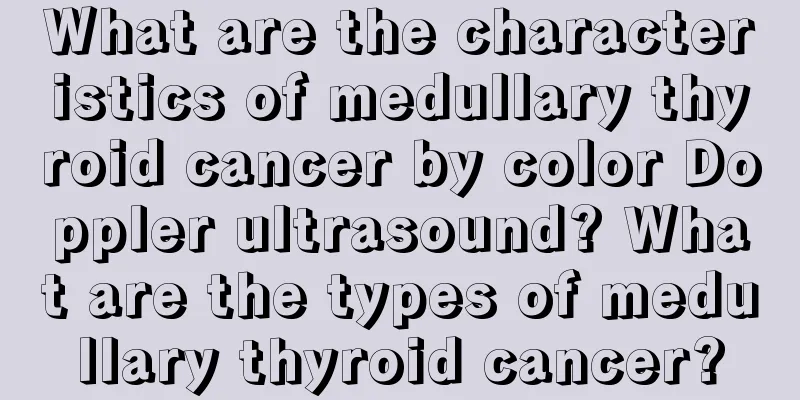What are the characteristics of medullary thyroid cancer by color Doppler ultrasound? What are the types of medullary thyroid cancer?

|
Medullary thyroid cancer is a disease that troubles many people. Patients who develop the disease will suffer greatly from the disease. Medullary thyroid cancer requires professional equipment for examination and professional doctors and drugs for treatment. The examination results of professional equipment can be used to judge the health status of the patient and the severity of medullary thyroid cancer. Ultrasound features of medullary thyroid carcinoma: Compared with papillary thyroid carcinoma, medullary thyroid carcinoma has its own characteristics in ultrasound images. According to the size of the tumor, the ultrasound image of medullary thyroid carcinoma with a diameter of less than 1 cm is similar to that of micropapillary carcinoma, with low echo, unclear boundaries, irregular shape, and calcification. Due to the nutritional needs of malignant tumors, they are mostly spherical and have large vertical and horizontal ratios. However, when the tumor diameter is greater than 1 cm, the image of medullary thyroid carcinoma is mostly oval, with regular boundaries and coarse calcification, and lymph node metastasis is prone to occur. 1. Medullary thyroid cancer can be divided into two types: sporadic and hereditary. Hereditary medullary thyroid cancer occurs 10-20 years earlier than sporadic medullary thyroid cancer and is more common in males than in females. Hereditary medullary thyroid cancer is an autosomal dominant genetic disease. Patients with medullary thyroid cancer and their first-degree relatives should undergo gene testing for the oncogene RET mutation. 2. Thyroid color Doppler ultrasound examination alone is difficult to differentiate from other thyroid cancers. If the tumor is large, ultrasound-guided puncture examination is a highly sensitive means of diagnosis. If the preoperative calcitonin level is greater than 100ng/L, it can basically be diagnosed as medullary thyroid cancer. If lung, liver or bone metastasis is suspected, lung CT or whole body bone scan and other related examinations should be performed to make a judgment. 3. Medullary thyroid cancer is not sensitive to radiotherapy and chemotherapy. At the same time, the paracrine cells of the thyroid follicles do not absorb iodine. 131I radiotherapy is ineffective for medullary thyroid cancer. Medullary thyroid cancer may spread intraglandularly. The recurrence rate is low after total thyroidectomy. Therefore, regardless of whether it is sporadic or hereditary medullary thyroid cancer, the best surgical method is total thyroidectomy. There was no statistically significant difference in the impact of different initial symptoms, various types of staging, different surgical methods for primary lesions, neck lymph node dissection surgical methods, whether the neck lymph nodes were metastatic, treatment methods, whether there was recurrence, and whether there were endocrine symptoms such as diarrhea on the prognosis. |
Recommend
Early symptoms of uterine cancer
Uterine cancer is a common gynecological malignan...
Kidney cancer patients do not necessarily have to have their kidneys removed
When it comes to kidney cancer, many people belie...
Fine movements of 27 fingers
When the baby is one year old, parents should tra...
Can peanuts soaked in vinegar help enlarge breasts?
Many women have less full breasts and less elasti...
Is it serious if urine turns orange?
If the color of urine is orange, you should pay a...
Tell you about the care measures for laryngeal cancer
Laryngeal cancer refers to a tumor in the throat....
Beware of the early warning signs of testicular cancer
Modern people's awareness of disease preventi...
Are latex pillows harmful to the human body?
Nowadays, people's sleep quality is not so go...
Dietary health care measures for ovarian tumors
The eating habits of ovarian tumor patients are v...
Is teeth whitening just about removing tartar?
A mouthful of neat and white teeth makes you smil...
Is it good to drink soy milk on an empty stomach in the morning? The truth is this
Soy milk is a common soy drink in daily life and ...
What are the symptoms of advanced liver cancer? There are four major symptoms of advanced liver cancer
In recent years, due to the development of the na...
What is the relationship between allergic rhinitis and allergic asthma?
Especially after entering the autumn and winter s...
How much does it cost to treat nasopharyngeal cancer? What are the low-cost treatment methods?
How much does it cost to treat nasopharyngeal can...
There are many medical treatments for nasopharyngeal carcinoma
The treatment of nasopharyngeal carcinoma can be ...









